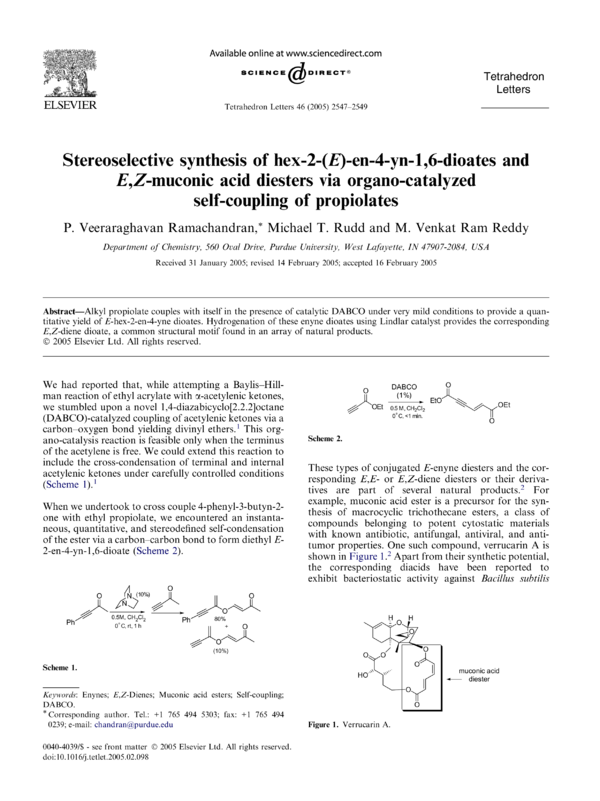Stereoselective synthesis of hex-2-(E)-en-4-yn-1,6-dioates and E,Z-muconic acid diesters via organo-catalyzed self-coupling of propiolates
Stereoselective synthesis of hex-2-(E)-en-4-yn-1,6-dioates and E,Z-muconic acid diesters via organo-catalyzed self-coupling of propiolates
Journal:
Year:
Abstract:
Alkyl propiolate couples with itself in the presence of catalytic DABCO under very mild conditions to provide a quantitative yield of E-hex-2-en-4-yne dioates. Hydrogenation of these enyne dioates using Lindlar catalyst provides the corresponding E,Z-diene dioate, a common structural motif found in an array of natural products.

DOI:
10.1016/j.tetlet.2005.02.098
Type of document:
Language:
Tetrahedron
Letters
Tetrahedron Letters 46 (2005) 2547–2549
Stereoselective synthesis of hex-2-(E)-en-4-yn-1,6-dioates and
E,Z-muconic acid diesters via organo-catalyzed
self-coupling of propiolates
P. Veeraraghavan Ramachandran,* Michael T. Rudd and M. Venkat Ram Reddy
Department of Chemistry, 560 Oval Drive, Purdue University, West Lafayette, IN 47907-2084, USA
Received 31 January 2005; revised 14 February 2005; accepted 16 February 2005
Abstract—Alkyl propiolate couples with itself in the presence of catalytic DABCO under very mild conditions to provide a quantitative yield of E-hex-2-en-4-yne dioates. Hydrogenation of these enyne dioates using Lindlar catalyst provides the corresponding
E,Z-diene dioate, a common structural motif found in an array of natural products.
Ó 2005 Elsevier Ltd. All rights reserved.
We had reported that, while attempting a Baylis–Hillman reaction of ethyl acrylate with a-acetylenic ketones,
we stumbled upon a novel 1,4-diazabicyclo[2.2.2]octane
(DABCO)-catalyzed coupling of acetylenic ketones via a
carbon–oxygen bond yielding divinyl ethers.1 This organo-catalysis reaction is feasible only when the terminus
of the acetylene is free. We could extend this reaction to
include the cross-condensation of terminal and internal
acetylenic ketones under carefully controlled conditions
(Scheme 1).1
When we undertook to cross couple 4-phenyl-3-butyn-2one with ethyl propiolate, we encountered an instantaneous, quantitative, and stereodefined self-condensation
of the ester via a carbon–carbon bond to form diethyl E2-en-4-yn-1,6-dioate (Scheme 2).
O
Ph
N
N
(10%)
0.5M, CH2Cl2
0° C, rt, 1 h
O
DABCO
(1%)
O
OEt
EtO
0.5 M, CH2Cl2
0° C, 0.2%.3
These diacids are also useful as cross-linking agents for
OH-containing materials, such as cellulose, and as intermediates for insecticides.3 Accordingly, several syntheses of muconic acid diesters have been reported.4
A literature search revealed a stoichiometric reaction of
methyl propiolate with triethylamine, N-methylpiperidine,
or N-methylpyrrolidine to form the enyne dioate in
moderate to high yields.5 A patent also disclosed the
dimerization of propiolate esters in the presence of
10% of a tertiary amine at temperatures ranging from
À10 to 100 °C for several hours.3,6 Numerous amines,
including DABCO, pyridine and picoline were reported
to be effective. It is surprising that there has been no
earlier reference to this patent, although several applications of muconic acid esters have since been reported.
Our experiments established that long reaction times
and extreme conditions are not necessary for the coupling. This study focused on the limitations of the
instantaneous and catalyzed reaction. No influence of
solvents was observed. Various amines, aromatic and
aliphatic, were tested as organic catalysts. Differing from
the claim in the patent, pyridine and picoline were ineffective for catalysis. TMEDA compares well with the
efficacy of DABCO. However, DBU failed to catalyze
the reaction (Table 1).
tion. Decreasing the catalyst further results in an incomplete reaction. We chose 1% catalyst at 0 °C as the
standard condition for the reaction with the catalyst
being removed at the end of the reaction by filtration
through a pad of silica. We prepared a series of aromatic
and aliphatic propiolate esters via DCC mediated esterification of propiolic acid, including esters from chiral
alcohols. In all of the cases, we experienced no difficulty
in forming the enyne diesters (Scheme 3). In fact, the
reactions of aromatic esters were highly instantaneous
and exothermic and were carried out under controlled
conditions at low temperature.
The proposed mechanism of the catalytic cycle is as follows (Scheme 4).
We converted a representative enyne diester, diethyl 2Een-4-yn-1,6-dioate, to (E,Z)-muconic acid diester
(Scheme 5). Hydrogenation using Lindlar catalyst provided the corresponding E,Z-diene dioate. Selective
enzymatic hydrolysis of the E,Z-diester and conversion
to various other difunctionalized dienes is known.7 This
diene has also been applied in Diels–Alder reactions.8
A typical experimental procedure for the preparation of
diisopinocampheyl hex-2-(E)-en-4-yn-1,6-dioate and the
corresponding E,Z-dienoate is as follows. To a solution
Examination of the catalytic turnover revealed that
0.1 mol % of DABCO is sufficient to catalyze the reac-
O
COOR
OR
O
H
Catalyst
%
Catalyst
Solvent
Reaction
time
1
2
3
4
5
6
7
8
9
10
11
12
13
14
15
DABCO
DABCO
DABCO
DABCO
DABCO
DABCO
Et3N
TMEDA
DBU
Pyridine
Picoline
DABCO
DABCO
DABCO
DABCO
10
10
10
10
10
10
10
10
10
10
10
1
0.1
0.01
0.001
CH2Cl2
Hexane
EtOAc
CH3CN
Toluene
THF
CH2Cl2
CH2Cl2
CH2Cl2
CH2Cl2
CH2Cl2
CH2Cl2
CH2Cl2
THF
THF
Coments go here:
- Log in to post comments

